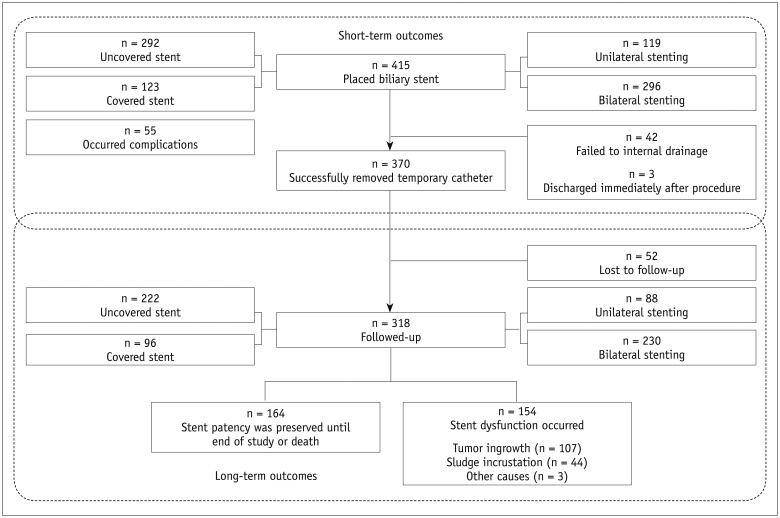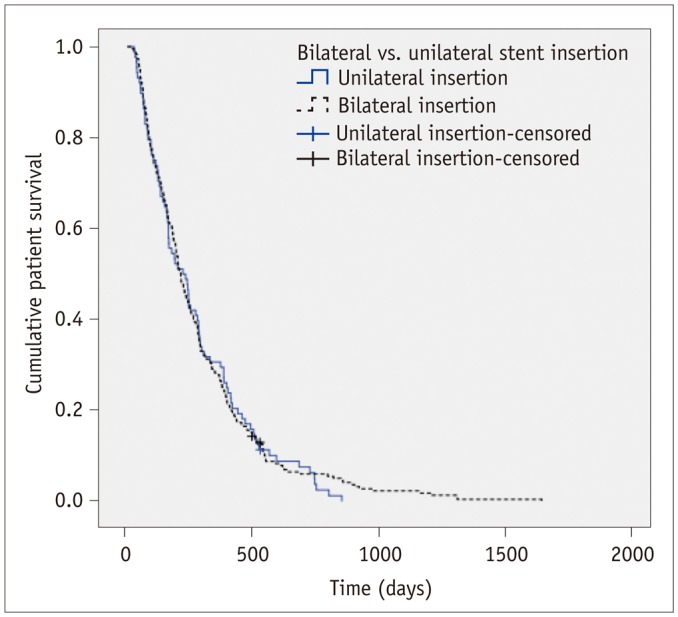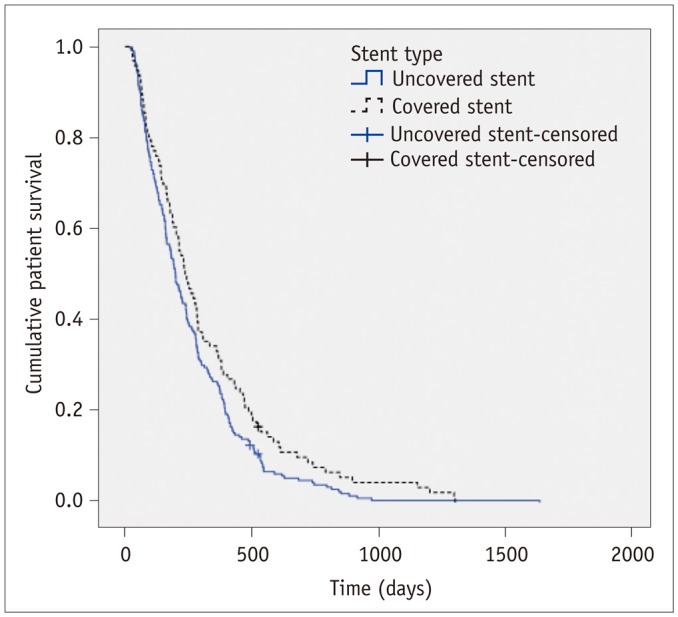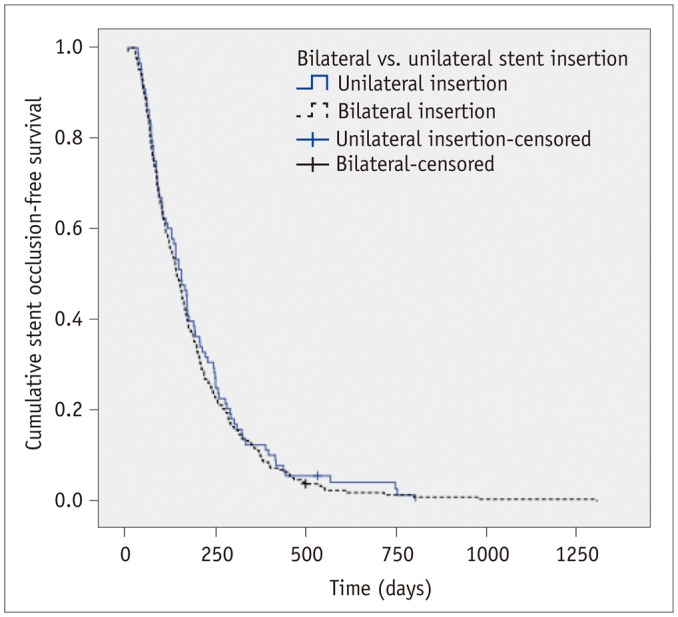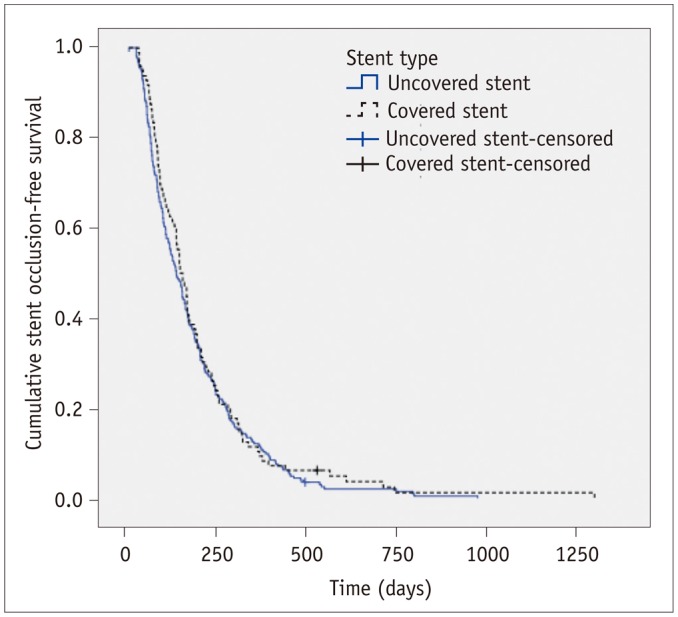Korean J Radiol.
2018 Aug;19(4):597-605. 10.3348/kjr.2018.19.4.597.
Percutaneous Metallic Stent Placement for Palliative Management of Malignant Biliary Hilar Obstruction
- Affiliations
-
- 1Department of Radiology, College of Medicine, Incheon St. Mary's Hospital, The Catholic University of Korea, Incheon 21431, Korea.
- 2Department of Radiology and Research Institute of Radiology, University of Ulsan College of Medicine, Asan Medical Center, Seoul 05505, Korea. radgwon@amc.seoul.kr
- 3Department of Radiology, Research Institute of Radiological Science, Yonsei University College of Medicine, Seoul 03722, Korea.
- 4Department of Radiology, Chungbuk National University Hospital, Cheongju 28644, Korea.
- KMID: 2413689
- DOI: http://doi.org/10.3348/kjr.2018.19.4.597
Abstract
OBJECTIVE
To investigate the outcomes of percutaneous metallic stent placements in patients with malignant biliary hilar obstruction (MBHO).
MATERIALS AND METHODS
From January 2007 to December 2014, 415 patients (mean age, 65 years; 261 men [62.8%]) with MBHO were retrospectively studied. All the patients underwent unilateral or bilateral stenting in a T, Y, or crisscross configuration utilizing covered or uncovered stents. The clinical outcomes evaluated were technical and clinical success, complications, overall survival rates, and stent occlusion-free survival.
RESULTS
A total of 784 stents were successfully placed in 415 patients. Fifty-five patients had complications. These complications included hemobilia (n = 19), cholangitis (n = 13), cholecystitis (n = 11), bilomas (n = 10), peritonitis (n = 1), and hepatic vein-biliary fistula (n = 1). Clinical success was achieved in 370 patients (89.1%). Ninety-seven patients were lost to follow-up. Stent dysfunction due to tumor ingrowth (n = 107), sludge incrustation (n = 44), and other causes (n = 3) occurred in 154 of 318 patients. The median overall survival and the stent occlusion-free survival were 212 days (95% confidence interval [CI], 186−237 days) and 141 days (95% CI, 126−156 days), respectively. The stent type and its configuration did not affect technical success, complications, successful internal drainage, overall survival, or stent occlusion-free survival.
CONCLUSION
Percutaneous stent placement may be safe and effective for internal drainage in patients with MBHO. Furthermore, stent type and configuration may not significantly affect clinical outcomes.
Keyword
MeSH Terms
Figure
Reference
-
1. Nakeeb A, Pitt HA, Sohn TA, Coleman J, Abrams RA, Piantadosi S, et al. Cholangiocarcinoma. A spectrum of intrahepatic, perihilar, and distal tumors. Ann Surg. 1996; 224:463–473. discussion 473-475. PMID: 8857851.2. Paik WH, Park YS, Hwang JH, Lee SH, Yoon CJ, Kang SG, et al. Palliative treatment with self-expandable metallic stents in patients with advanced type III or IV hilar cholangiocarcinoma: a percutaneous versus endoscopic approach. Gastrointest Endosc. 2009; 69:55–62. PMID: 18657806.
Article3. Glättli A, Stain SC, Baer HU, Schweizer W, Triller J, Blumgart LH. Unresectable malignant biliary obstruction: treatment by self-expandable biliary endoprostheses. HPB Surg. 1993; 6:175–184. PMID: 7683908.
Article4. Bae JI, Park AW, Choi SJ, Kim HP, Lee SJ, Park YM, et al. Crisscross-configured dual stent placement for trisectoral drainage in patients with advanced biliary hilar malignancies. J Vasc Interv Radiol. 2008; 19:1614–1619. PMID: 18823794.
Article5. Veal DR, Lee AY, Kerlan RK Jr, Gordon RL, Fidelman N. Outcomes of metallic biliary stent insertion in patients with malignant bilobar obstruction. J Vasc Interv Radiol. 2013; 24:1003–1010. PMID: 23796087.
Article6. van Delden OM, Laméris JS. Percutaneous drainage and stenting for palliation of malignant bile duct obstruction. Eur Radiol. 2008; 18:448–456. PMID: 17960388.
Article7. Yi R, Gwon DI, Ko GY, Yoon HK, Kim JH, Shin JH, et al. Percutaneous unilateral placement of biliary covered metallic stent in patients with malignant hilar biliary obstruction and contralateral portal vein occlusion. Acta Radiol. 2012; 53:742–749. PMID: 22850575.
Article8. De Palma GD, Pezzullo A, Rega M, Persico M, Patrone F, Mastantuono L, et al. Unilateral placement of metallic stents for malignant hilar obstruction: a prospective study. Gastrointest Endosc. 2003; 58:50–53. PMID: 12838220.
Article9. Gwon DI, Ko GY, Sung KB, Yoon HK, Shin JH, Hyoung Kim J, et al. Percutaneous biliary metallic stent placement in patients with unilobar portal vein occlusion caused by advanced hilar malignancy: outcome of unilateral versus bilateral stenting. AJR Am J Roentgenol. 2011; 197:795–801. PMID: 21940566.
Article10. Chang WH, Kortan P, Haber GB. Outcome in patients with bifurcation tumors who undergo unilateral versus bilateral hepatic duct drainage. Gastrointest Endosc. 1998; 47:354–362. PMID: 9609426.
Article11. Hsieh J, Thosani A, Grunwald M, Nagula S, Bucobo JC, Buscaglia JM. Serial insertion of bilateral uncovered metal stents for malignant hilar obstruction using an 8 Fr biliary system: a case series of 17 consecutive patients. Hepatobiliary Surg Nutr. 2015; 4:348–353. PMID: 26605283.12. De Palma GD, Galloro G, Siciliano S, Iovino P, Catanzano C. Unilateral versus bilateral endoscopic hepatic duct drainage in patients with malignant hilar biliary obstruction: results of a prospective, randomized, and controlled study. Gastrointest Endosc. 2001; 53:547–553. PMID: 11323577.
Article13. Schoder M, Rossi P, Uflacker R, Bezzi M, Stadler A, Funovics MA, et al. Malignant biliary obstruction: treatment with ePTFE-FEP- covered endoprostheses initial technical and clinical experiences in a multicenter trial. Radiology. 2002; 225:35–42. PMID: 12354981.14. Gwon DI, Ko GY, Yoon HK, Kim YJ, Kim TH, Lee WH, et al. Safety and efficacy of percutaneous Y-configured covered stent placement for malignant hilar biliary obstruction: a prospective, pilot study. J Vasc Interv Radiol. 2012; 23:528–534. PMID: 22341884.
Article15. Hyun H, Choi SY, Kim KA, Ko SB. Safety and efficacy of percutaneous biliary covered stent placement in patients with malignant biliary hilar obstruction; correlation with liver function. Cardiovasc Intervent Radiol. 2016; 39:1298–1305. PMID: 27224987.
Article16. Sacks D, McClenny TE, Cardella JF, Lewis CA. Society of Interventional Radiology clinical practice guidelines. J Vasc Interv Radiol. 2003; 14(9 Pt 2):S199–S202. PMID: 14514818.
Article17. Inal M, Akgül E, Aksungur E, Seydaoğlu G. Percutaneous placement of biliary metallic stents in patients with malignant hilar obstruction: unilobar versus bilobar drainage. J Vasc Interv Radiol. 2003; 14:1409–1416. PMID: 14605106.
Article18. Son RC, Gwon DI, Ko HK, Kim JW, Ko GY. Percutaneous unilateral biliary metallic stent placement in patients with malignant obstruction of the biliary hila and contralateral portal vein steno-occlusion. Korean J Radiol. 2015; 16:586–592. PMID: 25995688.
Article19. Ichikawa H, Yamanaka K, Tobe T, Mizumoto R. Bile secretion in regenerating liver--a comparison of hepatic resection and ligation of the portal vein branch in dogs. Gastroenterol Jpn. 1984; 19:320–327. PMID: 6489692.
Article20. Hadjis NS, Adam A, Gibson R, Blenkharn JI, Benjamin IS, Blumgart LH. Nonoperative approach to hilar cancer determined by the atrophy-hypertrophy complex. Am J Surg. 1989; 157:395–399. PMID: 2539024.
Article21. Gwon DI, Ko GY, Kim JH, Shin JH, Kim KA, Yoon HK, et al. Percutaneous bilateral metallic stent placement using a stentin-stent deployment technique in patients with malignant hilar biliary obstruction. AJR Am J Roentgenol. 2013; 200:909–914. PMID: 23521469.
Article22. Kim CW, Park AW, Won JW, Kim S, Lee JW, Lee SH. T-configured dual stent placement in malignant biliary hilar duct obstructions with a newly designed stent. J Vasc Interv Radiol. 2004; 15:713–717. PMID: 15231885.
Article23. Gwon DI, Ko GY, Yoon HK, Kim JH, Lee JM, Ohm JY, et al. Prospective evaluation of a newly designed T-configured stent graft system for palliative treatment of advanced hilar malignant biliary obstructions. J Vasc Interv Radiol. 2010; 21:1410–1418. PMID: 20800780.
Article24. Gwon DI, Ko GY, Kim JH, Yoon HK, Lee IS, Kim KA, et al. A comparative analysis of PTFE-covered and uncovered stents for palliative treatment of malignant extrahepatic biliary obstruction. AJR Am J Roentgenol. 2010; 195:W463–W469. PMID: 21098180.
Article25. Li M, Li K, Qi X, Wu W, Zheng L, He C, et al. Percutaneous transhepatic biliary stent implantation for obstructive jaundice of perihilar cholangiocarcinoma: a prospective study on predictors of stent patency and survival in 92 patients. J Vasc Interv Radiol. 2016; 27:1047–1055.e2. PMID: 27241392.
Article
- Full Text Links
- Actions
-
Cited
- CITED
-
- Close
- Share
- Similar articles
-
- Interventional radiologic approach to hilar malignant biliary obstruction
- Multiple metallic stents placement for malignant hilar biliary obstruction: Perspective of a radiologist
- Technical Tips and Issues of Biliary Stenting, Focusing on Malignant Hilar Obstruction
- Combined Treatment with Metallic Stent Placement and Radiotherapy in Malignant Biliary Obstruction
- Endoscopic Stent Placement in the Palliation of Malignant Biliary Obstruction

